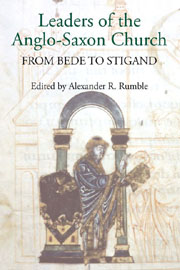Book contents
- Frontmatter
- Contents
- List of Illustrations
- Preface
- Contributors
- Abbreviations
- Introduction: Church Leadership and the Anglo-Saxons
- 1 Bede and the Early English Church
- 2 Archbishop Ecgberht and his Dialogus
- 3 Abbatial Responsibility as Spiritual Labour: Suckling from the Male Breast
- 4 Understanding the Earliest Bishops of Worcester c. 660–860
- 5 The Role of Bishops in Anglo-Saxon Succession Struggles, 955 × 978
- 6 Image-Making: Portraits of Anglo-Saxon Church Leaders
- 7 ‘To Keep Silence Following the Rule's Command’: Bishop Æthelwold, Reforming Ideology and Communication by Signs
- 8 Wulfsige of Sherborne's Reforming Text
- 9 From Winchester to Canterbury: Ælfheah and Stigand – Bishops, Archbishops and Victims
- Index
1 - Bede and the Early English Church
Published online by Cambridge University Press: 05 February 2013
- Frontmatter
- Contents
- List of Illustrations
- Preface
- Contributors
- Abbreviations
- Introduction: Church Leadership and the Anglo-Saxons
- 1 Bede and the Early English Church
- 2 Archbishop Ecgberht and his Dialogus
- 3 Abbatial Responsibility as Spiritual Labour: Suckling from the Male Breast
- 4 Understanding the Earliest Bishops of Worcester c. 660–860
- 5 The Role of Bishops in Anglo-Saxon Succession Struggles, 955 × 978
- 6 Image-Making: Portraits of Anglo-Saxon Church Leaders
- 7 ‘To Keep Silence Following the Rule's Command’: Bishop Æthelwold, Reforming Ideology and Communication by Signs
- 8 Wulfsige of Sherborne's Reforming Text
- 9 From Winchester to Canterbury: Ælfheah and Stigand – Bishops, Archbishops and Victims
- Index
Summary
IN 731, Bede completed his Historia Ecclesiastica nostrae insulae ac igentis in libri v – his ‘Ecclesiastical History of our island and people in five books’, a work which he entitled internally the Historia Ecclesiastica gentis Anglorum (in the opening line of the Preface and in the headings of the contents lists which open each book). The core of the title is, however, the same in each case, the Historia Ecclesiastica. Unsurprisingly, Bede made frequent use of the word ‘ecclesia’ meaning ‘church’ across this work; it occurs 378 times. This term has several different significances, however, which we need to distinguish before we can really discuss Bede's conception of, and attitude towards, the early English church.
‘Ecclesia’ is frequently used in the Historia Ecclesiastica to refer to the universal Christian church, occurring in such phrases as ‘catholica et apostolica ecclesia’ (‘the catholic and apostolic church’), ‘ecclesia sua’ (‘his church’, i.e. ‘Christ's church’), ‘ecclesia catholica’ (‘the catholic church’) and ‘omnis ecclesia’ (‘the whole church’), all taken from V. 21, which features Abbot Ceolfrith's letter to King Nechtan. This document was, of course, urging unity on the Picts as regards the calculation of Easter, so made frequent use of the terminologies of universality and conformity, of which such phrases form a central part. This was a terminology with which Bede was very familiar, appearing as it does in the New Testament, most famously in Matt. XVI.18, in a passage which re appears in HE III. 25, but elsewhere also in the Epistles of St Paul.
- Type
- Chapter
- Information
- Leaders of the Anglo-Saxon ChurchFrom Bede to Stigand, pp. 25 - 40Publisher: Boydell & BrewerPrint publication year: 2012

